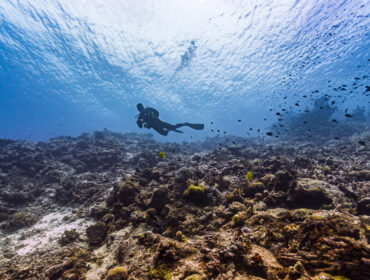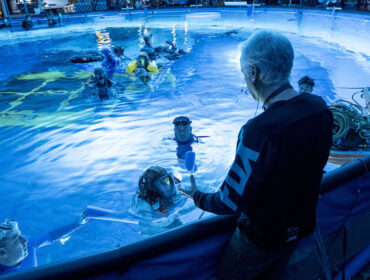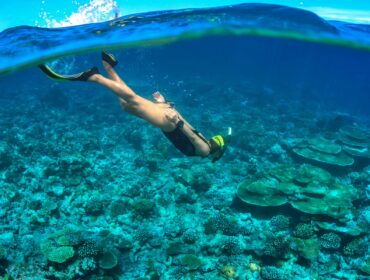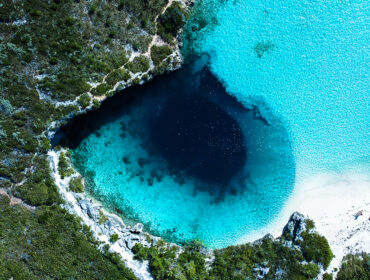With documentaries such as ‘Home Game’, ‘My Octopus Teacher’, and ‘The Deepest Breath’ (which just hit Netflix earlier this week), more and more people are becoming curious about the practice of freediving. But what exactly is freediving? Is it dangerous? And how deep can a person freedive on a single breath? If you are curious to find out the answers to these questions, and learn a little about the story of “The Deepest Breath,” you’ve come to the right place.
What is Freediving?
Scuba divers take a tank of air diving with them so that they can breathe as they go, whereas freedivers simply hold their breath instead. Freediving can be enjoyed in many ways but it all comes down to breath-holds.
Usually freediving involves swimming down under the water. Although, some people enjoy freediving in a swimming pool, or even lying still on the surface. Freediving is most often used to experience marine life up close, but there are also freediving competitions that test how deep someone can go, or how long they can hold their breath.
Everyone can freedive to a certain level. There are also courses and learning techniques to become more relaxed and move more efficiently in the water. This can make you a much better freediver, and help keep you safe.
Training for Deep Freediving
Freedivers who want to reach greater depths, or compete in competitions, have to train to achieve their goals. Each diver has a unique training plan that suits them but the most common things to think about when training for deep freediving are:
Add Depth Gradually
As mentioned above, freedivers must become comfortable with a certain depth before they try to go any deeper. With practice, deeper depths feel easier as the diver gains confidence and improves their breath-hold and diving technique.
Dry Exercises
A lot of training is done on dry land. Many freedivers struggle with equalizing their ears as they get deeper, so there are exercises to help with this. They will also stretch their body to become more flexible which makes moving underwater easier. Another helpful dry exercise to perform is regular dry static breath-holds to increase tolerance to high levels of carbon dioxide that build up when we hold our breath.
Workouts
Having a strong body can help freedivers to become deeper. Pulling and kicking to depth will feel easier if they are strong, and they will use less precious oxygen in the process.
Meditation
Meditation, breathwork, and similar mindfulness practices are a key part of training for deep freediving. A freediver must have a strong mind, and know how to relax and stay calm. This is arguably the most important part of deep freediving.
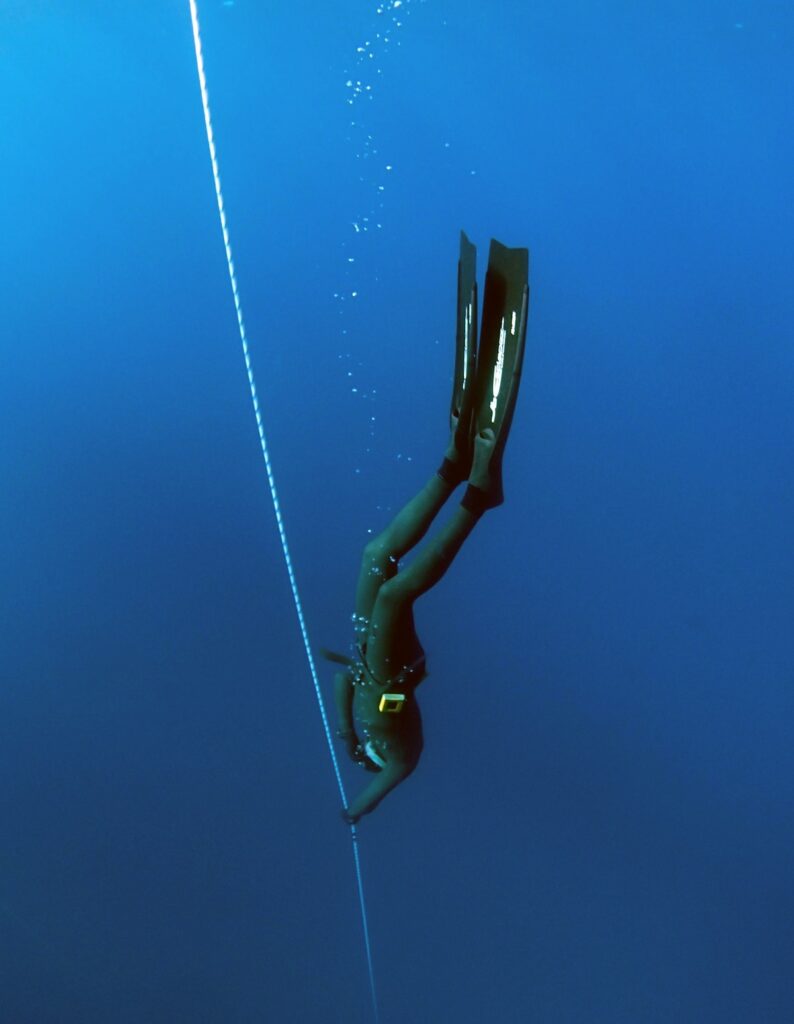
What Can Happen When a Freediver Goes Too Deep?
Freediving is generally very safe and can be enjoyed by mostly anybody. Although, just like any extreme sport, there are potential risks involved. Similarly to scuba diving, freedivers have to consider the increased pressure as they dive deeper underwater.
Lung Squeeze
Freedivers typically don’t have to worry about lung overexpansion injuries like scuba divers do (as they are not taking any extra air at depth). But they must still consider the effects of pressure on their lungs. The biggest worry in deep freediving is a lung squeeze.
A lung squeeze occurs when the lungs are squeezed from the pressure and blood vessels in the lungs burst. This can lead to the diver coughing up blood or, in the most severe cases, it can even cause death. To avoid a lung squeeze, freedivers must add depth gradually.
No beginner should try to dive to 300 feet deep, even if they have a very long breath-hold time. Adding depth gradually allows the lungs to adapt to the pressure slowly and reduces the risk of a lung squeeze.
Blackout
The second biggest worry in freediving is the risk of having a blackout. This occurs when the freediver becomes so starved of oxygen they pass out under or on the surface of the water. Generally this isn’t harmful to the diver as long as someone is there to bring them to the surface quickly. If no one is around, then the freediver will most likely take water into their lungs and drown. This is why the most important rule of freediving is to never dive alone. This is also why freedivers add depth gradually, so they can learn their capabilities in a safe way.
The Deepest Breath Documentary
“The Deepest Breath” is a documentary on Netflix that tells the story of a friendship between world champion competition freediver, Alessia Zecchini, and expert competition safety diver, Stephen Keenan.
The documentary first introduces us to a teenage Alessia, and we follow her journey over the years as she competes for Italy in freediving competitions, striving to become the world champion. We are also introduced to Steve, a world traveler who found his destiny in Egypt’s Red Sea where he built his own freediving center. Steve became head of safety at the most prestigious freediving competition in the world: Vertical Blue. The competition is held annually in the Bahamas.
As Alessia is struggling to improve her freediving results, Steve takes time out of his schedule to train with her. A special relationship is ignited and the two later head to Egypt to train together.
But becoming the deepest female freediver wasn’t Alessia’s only goal. She also wanted to freedive the infamous “arch” tunnel at a dive site known as Blue Hole in Dahab, Egypt. Many scuba divers have tragically lost their lives attempting this dive over the years, and it has only been attempted by a handful of elite freedivers.
The arch dive takes the diver from the surface inside the blue hole, down to 170 feet deep, where they then have to swim horizontally for 100 feet through the tunnel, before making their way back to the surface another 170 feet vertically up. It is a truly extreme dive to attempt on breath-hold.
An emotional rollercoaster from start to finish, “The Deepest Breath” showcases the determination and passion of competition freedivers, while also telling an emotional story of true friendship, enormous trust, and ultimate selflessness.
Freediving: Frequently Asked Questions
What is the deepest free dive ever?
As we discussed above, there are different ways to freedive. The deepest ever recorded breath-hold dive was to 830 feet deep! The freediver who achieved this was Herbert Nitsch and he did it using the no limits discipline.
The no limits discipline requires the diver to hold onto a weighted sled that drags them quickly to their desired depth. To get back to the surface, the diver inflates a bag using a scuba cylinder attached to the sled. This discipline has since been banned in competition due to its risky nature and extreme depth potential.
The deepest dive while swimming is 436 feet deep. This dive was performed by world champion Alexey Molchanov in June 2023 using a monofin (a dolphin-like fin over both feet). He continues to dive in regular competitions year-round.
How long can an average person hold their breath?
The average person can hold their breath for around a minute to a minute and a half. With freediving training, this can become much longer after a little practice.
What is the world’s record for the longest time someone has held their breath underwater?
The longest static breath-hold (lying still on the surface) is 11 minutes and 35 seconds, which was achieved by freediver Stephane Mifsud in 2009.
If a person breathes pure oxygen before a breath-hold they are capable of achieving much longer breath-holds. The world record for longest oxygen-assisted breath-hold is 24 minutes and 37 seconds by Budimir Šobat in 2021.
What device do scuba divers typically use to breathe underwater?
Scuba divers breathe underwater by using a tank filled with compressed air. This tank is attached to their buoyancy control device (a type of inflatable jacket). The air is carried from the tank to the diver’s mouth via hoses with regulators on the end. The scuba diver holds this in their mouth for the whole dive.



